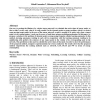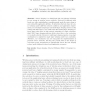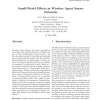427 search results - page 58 / 86 » Revisiting the lifetime of wireless sensor networks |
AHSWN
2010
13 years 10 months ago
2010
One way to prolong the lifetime of a wireless sensor network is to schedule the active times of sensor nodes, so that a node is active only when it is really needed. In the dynami...
EWSN
2009
Springer
14 years 10 months ago
2009
Springer
Sensor sleeping is a widely-used and cost-effective technique to save energy in wireless sensor networks. Protocols at different stack levels can, either individually or simultaneo...
APNOMS
2008
Springer
13 years 11 months ago
2008
Springer
Abstract. Wireless sensor network is a suitable technology for ubiquitous environment. However, in WSN, as the network size grows larger, overheads such as flooding, calculation an...
COMCOM
2010
13 years 10 months ago
2010
For data-collection applications in sensor networks, it is important to ensure base station receives a complete picture about the monitored area. Convergecast is an important commu...
IJWMC
2010
13 years 7 months ago
2010
Coverage, fault tolerance and power consumption constraints make optimal placement of mobile sensors or other mobile agents a hard problem. We have developed a model for describin...



